Safety Bulletin

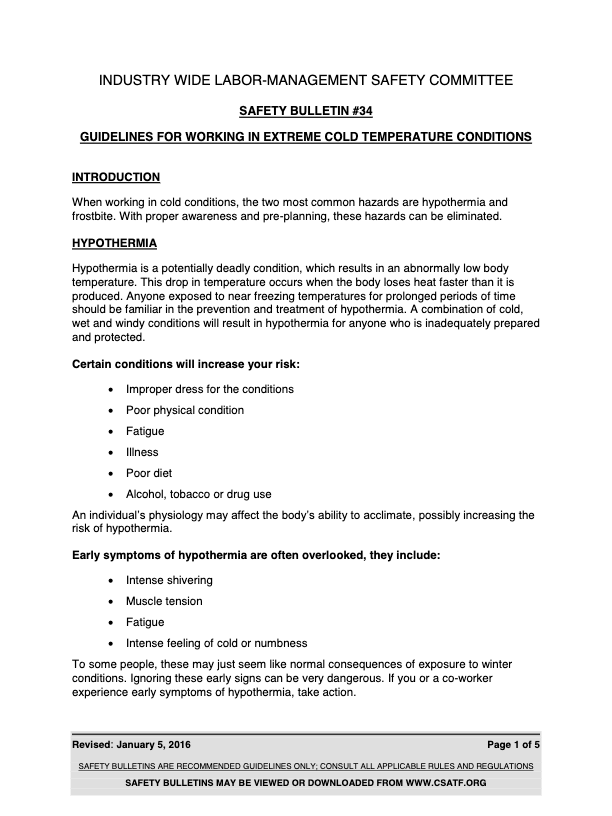
When working in cold conditions, the two most common hazards are hypothermia and frostbite. With proper awareness and pre-planning, these hazards can be eliminated.
Hypothermia is a potentially deadly condition, which results in an abnormally low body temperature. This drop in temperature occurs when the body loses heat faster than it is produced. Anyone exposed to near freezing temperatures for prolonged periods of time should be familiar in the prevention and treatment of hypothermia. A combination of cold, wet and windy conditions will result in hypothermia for anyone who is inadequately prepared and protected.
Certain conditions will increase your risk:
An individual’s physiology may affect the body’s ability to acclimate; possibly, increasing the risk.
Early symptoms of hypothermia are often overlooked, they include:
To most people, these may just seem like normal consequences of exposure to winter conditions. Ignoring these early signs can be very dangerous. If you or a co-worker experience early symptoms of hypothermia, take action.
Also watch for additional behavioral signs including:
At the first sign of any of these conditions, notify your supervisor and/or seek medical attention (i.e., set medic, studio hospital or medical provider) then go inside and get warm, before you attempt to complete the job or project you are working on.
Preventing hypothermia is not difficult. In fact, it is much easier to avoid hypothermia than to treat it after the fact. You can prevent hypothermia if you pre-plan, know what the conditions are expected to be and plan your clothing accordingly.
Some clothing tips to remember:
Food and behavior:
If you are working in cold weather, remember these tips:
Consider the following:
If someone is showing signs of hypothermia:
Frostbite is more common than hypothermia. It is the result of the freezing of the extracellular fluid in the skin, which can permanently damage the tissue. This condition usually affects the extremities, such as the tips of fingers, the ears and nose but other exposed areas can also be affected. Like hypothermia, a combination of elements usually leads to frostbite not cold air alone. In fact, most frostbite is the result of conduction, the rapid transfer of heat, for example, touching cold metal surfaces with bare hands. Exposure to cold temperatures and wind can quickly result in frostbite.
Factors that can increase your risk of frostbite are:
Just as with hypothermia, frostbite is much easier to prevent than it is to treat. All of the items listed above for hypothermia would also apply for frostbite.
If you think you may have frostbite, even a mild case, immediately seek medical attention.
The following list will provide some guidelines for treating frostbite:
The following are some additional steps the production can take to minimize the risks:
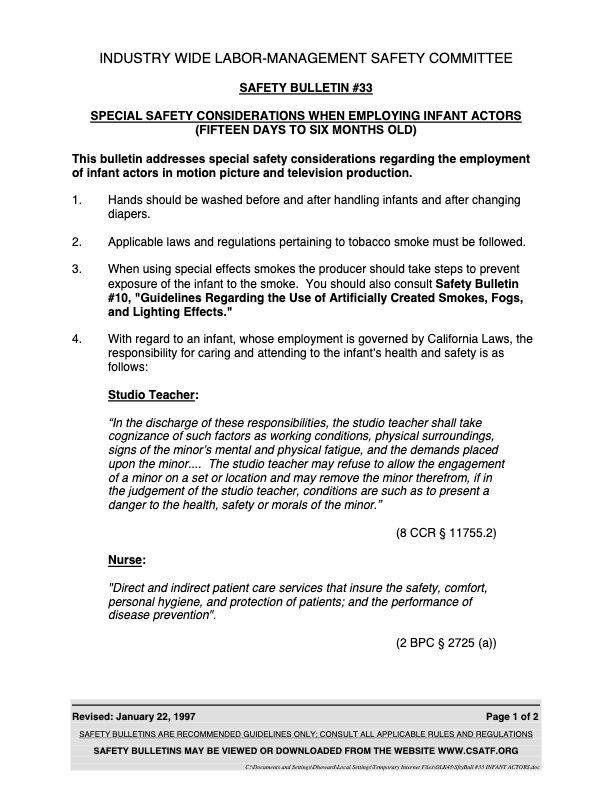
This bulletin addresses special safety considerations regarding the employment of infant actors (fifteen-days to six-months old) in motion picture and television production.
Note: All production personnel working with infants are urged to review the “Blue Book,” entitled “The Employment of Minors in the Entertainment Industry,” published by the Studio Teachers, Local 884, IATSE. Reference should also be made to the extensive federal and state labor laws and to any applicable collective bargaining agreements which govern the employment of child actors.
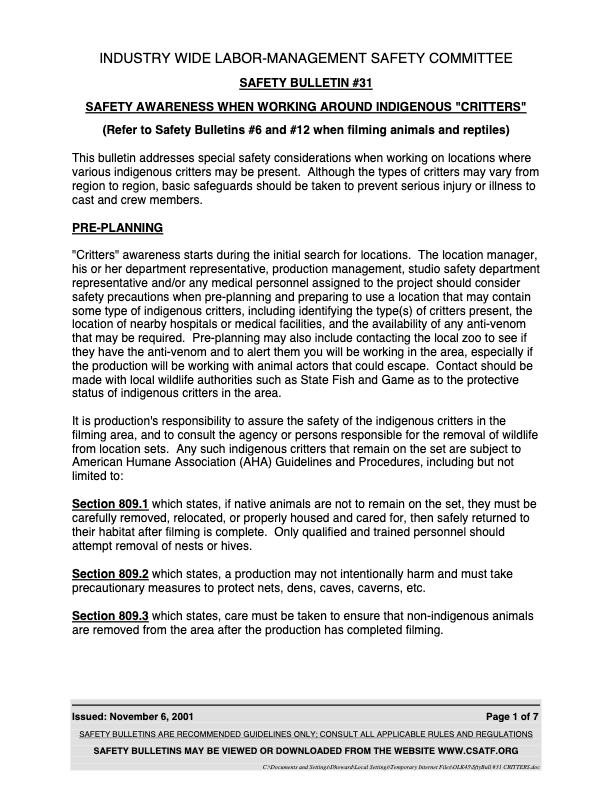
This bulletin addresses special safety considerations when working on locations where various indigenous critters may be present. Although the types of critters may vary from region to region, basic safeguards should be taken to prevent serious injury or illness to cast and crew members.
Critter awareness starts during the initial search for locations. The location manager, his or her department representative, production management, studio safety department representative and/or any medical personnel assigned to the project should consider safety precautions when pre-planning and preparing to use a location that may contain some type of indigenous critters, including identifying the type(s) of critters present, the location of nearby hospitals or medical facilities, and the availability of any anti-venom that may be required. Pre-planning may also include contacting the local zoo to see if they have the anti-venom and to alert them you will be working in the area, especially if the production will be working with animal actors that could escape. Contact should be made with local wildlife authorities such as State Fish and Game as to the protective status of indigenous critters in the area.
It is production’s responsibility to assure the safety of the indigenous critters in the filming area, and to consult the agency or persons responsible for the removal of wildlife from location sets. Any such indigenous critters that remain on the set are subject to American Humane Association (AHA) Guidelines and Procedures, including but not limited to:
Animal actors brought to a location can be affected by other indigenous critters: this could range from distraction to life threatening situations or the transmittal of diseases between critters. Notification should be provided to the professional trainer/supplier of the animal actors.
If you have additional questions regarding the AHA’s Guidelines for the Safe Use of Animals in Filmed Media, contact the Film and Television Unit at (818) 501-0123.
Since there are numerous types of critters, there is no way this Safety Bulletin can cover all of the various types. The following are some of the more commonly encountered critters on locations.
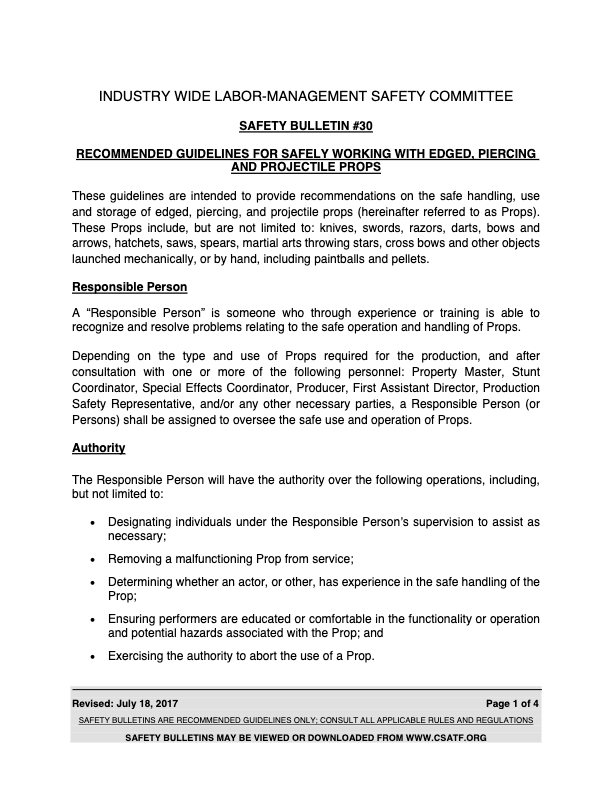
These guidelines are intended to provide recommendations on the safe handling, use and storage of edged, piercing, and projectile props (hereinafter referred to as Props). These Props include, but are not limited to: knives, swords, razors, darts, bows and arrows, hatchets, saws, spears, martial arts throwing stars, cross bows and other objects launched mechanically, or by hand, including paintballs and pellets.
A “Responsible Person” is someone who through experience or training is able to recognize and resolve problems relating to the safe operation and handling of Props.
Depending on the type and use of Props required for the production, and after consultation with one or more of the following personnel: Property Master, Stunt Coordinator, Special Effects Coordinator, Producer, First Assistant Director, Production Safety Representative, and/or any other necessary parties, a Responsible Person (or Persons) shall be assigned to oversee the safe use and operation of Props.
The Responsible Person will have the authority over the following operations, including, but not limited to:
The Responsible Person or designated individual should do the following:
The First Assistant Director should, along with the Responsible Person and other necessary personnel, conduct a safety meeting with cast and crew prior to working around Props.
Make cast and crew aware of the Responsible Person (or designee) authorized to handle the Props.
Safety meeting topics may include, but are not limited to:
The Responsible Person should be notified of any changes or concerns in the use of the Props, action of the cast or crew, or placement of equipment in order to determine whether an additional safety meeting is necessary.
All state and federal safety regulations are applicable and override these guidelines if they are more stringent.
Allow sufficient time to train performers and to rehearse the action so that everyone involved knows what their part in the action will be.
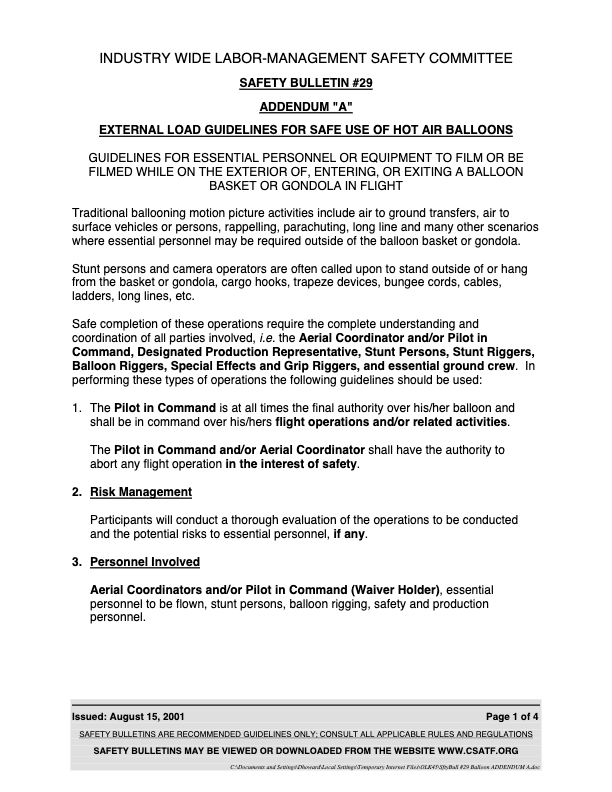
Traditional ballooning motion picture activities include air to ground transfers, air to surface vehicles or persons, rappelling, parachuting, long line and many other scenarios where essential personnel may be required outside of the balloon basket or gondola.
Stunt persons and camera operators are often called upon to stand outside of or hang from the basket or gondola, cargo hooks, trapeze devices, bungee cords, cables, ladders, long lines, etc.
Safe completion of these operations require the complete understanding and coordination of all parties involved, i.e. the Aerial Coordinator and/or Pilot in Command, Designated Production Representative, Stunt Persons, Stunt Riggers, Balloon Riggers, Special Effects and Grip Riggers, and essential ground crew.
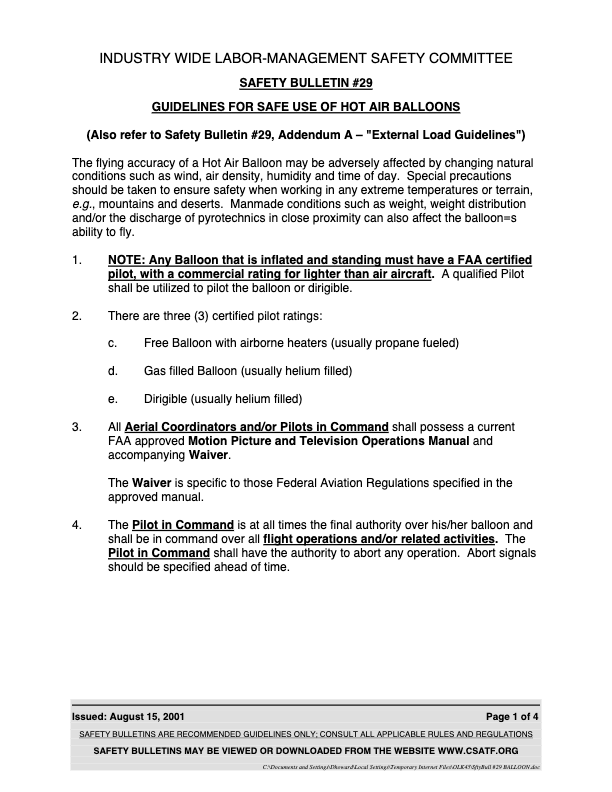
The flying accuracy of a Hot Air Balloon may be adversely affected by changing natural conditions such as wind, air density, humidity and time of day. Special precautions should be taken to ensure safety when working in any extreme temperatures or terrain, e.g., mountains and deserts. Manmade conditions such as weight, weight distribution and/or the discharge of pyrotechnics in close proximity can also affect the balloon’s ability to fly.
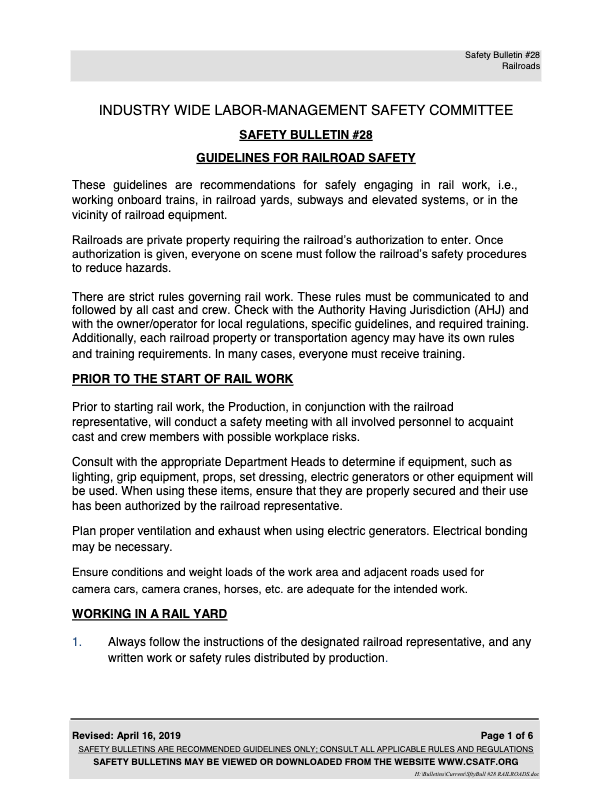
These guidelines are recommendations for safely engaging in rail work, i.e., working onboard trains, in railroad yards, subways and elevated systems, or in the vicinity of railroad equipment.
Railroads are private property requiring the railroad’s authorization to enter. Once authorization is given, everyone on scene must follow the railroad’s safety procedures to reduce hazards.
There are strict rules governing rail work. These rules must be communicated to and followed by all cast and crew. Check with the Authority Having Jurisdiction (AHJ) and with the owner/operator for local regulations, specific guidelines, and required training. Additionally, each railroad property or transportation agency may have its own rules and training requirements. In many cases, everyone must receive training.
Prior to starting rail work, the Production, in conjunction with the railroad representative, will conduct a safety meeting with all involved personnel to acquaint cast and crew members with possible workplace risks.
Consult with the appropriate Department Heads to determine if equipment, such as lighting, grip equipment, props, set dressing, electric generators or other equipment will be used. When using these items, ensure that they are properly secured and their use has been authorized by the railroad representative.
Plan proper ventilation and exhaust when using electric generators. Electrical bonding may be necessary.
Ensure conditions and weight loads of the work area and adjacent roads used for camera cars, camera cranes, horses, etc. are adequate for the intended work.
Some transit systems, (e.g., airport and amusement park people movers) are automated, meaning that they do not rely on onboard operators or engineers. Automated systems present unique hazards as there is usually no person on board to warn or stop the train if someone or something is on the track.
NEVER enter into an automated system when it is operational. If the production requires the filming of an automated system, a safety plan must be developed with the system owner/operator to ensure safety of all parties.
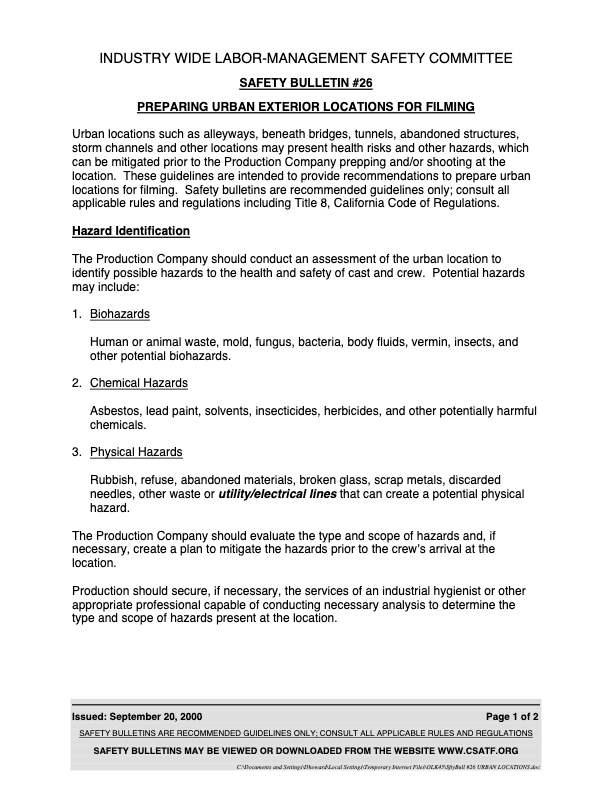
Urban locations such as alleyways, beneath bridges, tunnels, abandoned structures, storm channels and other locations may present health risks and other hazards, which can be mitigated prior to the Production Company prepping and/or shooting at the location. These guidelines are intended to provide recommendations to prepare urban locations for filming.
The Production Company should conduct an assessment of the urban location to identify possible hazards to the health and safety of cast and crew. Potential hazards may include:
The Production Company should evaluate the type and scope of hazards and, if necessary, create a plan to mitigate the hazards prior to the crew’s arrival at the location.
Production should secure, if necessary, the services of an industrial hygienist or other appropriate professional capable of conducting necessary analysis to determine the type and scope of hazards present at the location.
The Production Company should take necessary steps to minimize exposure of cast and crew to the aforementioned hazards. Such steps may include, but are not limited to, power washing, steam cleaning, removal of refuse and rubbish, fumigation, and use of chemical disinfectant(s). Because of the nature of such locations, production should consider securing the location during and after mitigation procedures.
In some cases, the type and/or scope of hazards present at the urban location may necessitate the use of a licensed contractor certified in the proper handling and removal of the offending substances and materials.
Electrical cables, props, and other equipment used at the location should be protected where practical. Cables should be supported off the ground whenever possible.
Protective ground cover, such as layout board or other material, should be positioned in work areas to minimize contact with potentially affected areas. Props and equipment that come in contact with the ground should be disinfected. Washing facilities should be available for the cast and crew – who should be reminded to wash periodically and before meals. Long pants, long sleeved shirts, and hard-soled shoes are recommended to minimize contact. Proper personal protective equipment should be provided and used.
If possible, the urban location should be locked-off and secured to maintain the cleanliness of the set. If that is not practical, Production should conduct daily cleaning activities before crew call to remove any sources of exposure or hazards that accumulated during the Production Company’s absence.
Some mitigation procedures may cause objections from local authorities or the community. The Production Company should first check with local agencies to insure that their preparation activities do not violate local ordinances.